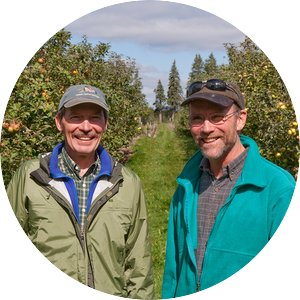The University of Minnesota is recognized as one of the top apple breeding and genetics research programs in the country. The apple breeding program began in the late 1800s with the goal of developing cold hardy apples that are both high quality and high yielding.
At any given time, our apple breeding program has 20,000 to 25,000 apple trees in various stages of evaluation. Most of the breeding and evaluation takes place at the Horticultural Research Center in Victoria. Our best apples undergo evaluation in commercial orchards in Minnesota and throughout the world as well as at other research centers across the U.S. before being released to the public.
Explore all University of Minnesota apple varieties
Breeding priorities
Our apple breeding efforts balance consumer-driven priorities with production concerns to develop apples that taste great and are economically sustainable for growers.
An apple's flavor, texture and appearance are the primary concerns, but our breeders also consider the fruit’s storage ability and shelf life so the quality of the apple is maintained from the orchard to the consumer.
Some of the traits our researchers select for in the breeding process include:
- Texture: crispness, juiciness, firmness
- Flavor: sweetness, acidity, aroma (flavor)
- Appearance: color, finish, shape
- Fruit size
- Storage ability
- Disease resistance: apple scab, fire blight
- Productivity
- Annual bearing
- Premature fruit drop
- Tree form
The Apple Breeding Process
Apple breeding takes time and patience. From the initial cross to release date, it takes on average 20-30 years for a new apple variety to hit the market. Our rigorous evaluation process and high quality standards allow only the best selections to advance through our testing process.
Year 1
Our researchers start the process by looking at performance and DNA data for various varieties and identifying what crosses they want to make. “Parent” varieties are paired to complement strengths and weaknesses and develop new cultivars with each parents’ most desired characteristics. For example, one parent may be disease resistant but not crisp and the other parent may be crisp but not disease resistant. The parents are crossed with the goal of developing a new cultivar that is both disease resistant and crisp.
After the crosses are planned, our researchers manually cross-pollinate flowers in much the same way that it occurs in nature. Flowers are pollinated by hand to ensure the planned crosses are made. The fruit that grows as a result of this pollination contains new, hybrid seeds.
These hybrid seeds are collected and brought to the greenhouse to germinate and grow. A leaf from each plant generated by the hybrid seed then undergoes DNA testing. DNA testing allows researchers to predict important traits and eliminate undesirable plants before they’re planted outside.
Years 2-5
Plants that make it through DNA testing are grafted onto a dwarfing rootstock and allowed to grow. The seedlings start to produce fruit around 5 years after initial crossing, and that’s when the real work begins. Researchers taste the apples from each seedling to evaluate the quality of fruit. Most trees are discarded during the first year of fruit bearing - only about 1 out of every 200 trees moves on to become a “selection” for further testing.
Years 5-15
Selections that move on to the next round of evaluation are cloned by grafting/budding onto common rootstocks and planted into a second test block. These selections are evaluated for another 10-15 years. This more rigorous evaluation looks at 25 tree and fruit characteristics. Again, most trees are discarded during this testing phase.
Years 15-20
Only the best of the best selections make it to our final round of testing. These trees are planted in commercial orchards in Minnesota and across the U.S. as well as at other research centers. If the selections perform well in these diverse settings and growers have interest in the apples, the commercialization process begins.
Years 20-25
A selection that makes it to commercialization must be named and given appropriate intellectual property protections before being publicly released. The newly released trees are licensed and distributed to commercial growers to begin propagating.
Years 25-30
Roughly 5 years after commercial growers begin propagating trees, the first substantial amount of fruit becomes available to consumers.
Apple breeding history
The University of Minnesota is known worldwide for its expertise in cold hardy variety research. For over a century, dedicated U of M researchers and fruit breeders have persevered in the development of hardy, high-quality apples that can thrive in harsh conditions of extremely cold winters and hot, dry summers.
The Minnesota climate is colder than most fruit-producing regions. It’s not surprising that the first apple breeding efforts in Minnesota looked to Russia; in 1865 about 150 apple varieties were imported for testing. In the early 1900s, U of M plant breeders collected wild trees as well as cultivars from New England and other Midwest breeders. Thousands of seedlings were grown from those parent trees. The record-breaking cold winter of 1917-1918 helped sort out the winners and the losers. Some progeny of 'Malinda', a New England variety, survived and led to the successful apples released in the 1920s, including 'Haralson' and 'Beacon.' Some 'Malinda' genes live on in varieties released decades later, including 'Honeygold.'
Apple seedlings are put through harsh trials of cold and disease. Today U of M researchers create severe winter conditions in laboratory freezers, inoculate seedlings with diseases, and use dwarfing rootstocks to reduce the years that a tree needs to produce fruit. Potential new varieties are also planted at commercial nurseries and at the University's North Central Research Center in Grand Rapids, Minnesota, the coldest horticultural research center in the lower 48 states. The research to arrive at desired qualities and characteristics takes decades.
University scientists also work to help home growers adopt strategies that can improve winter survival and pest management, such as bagging apples on trees when they are small to avoid pesticide use throughout the growing season.

